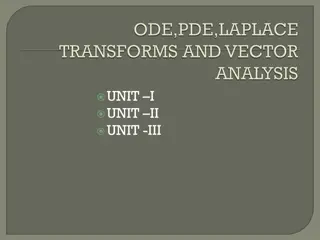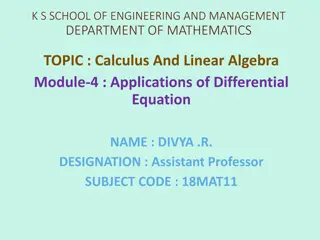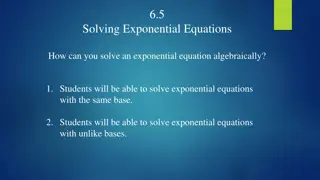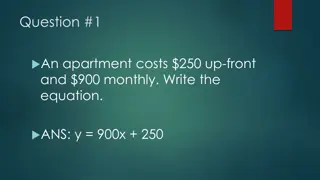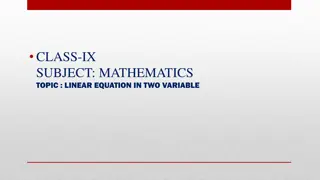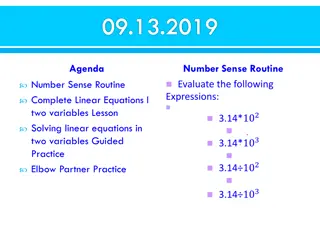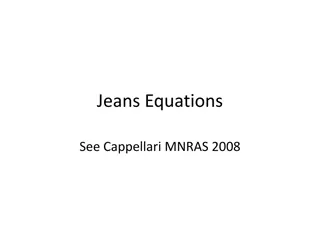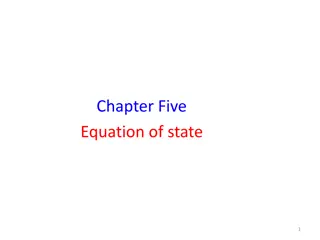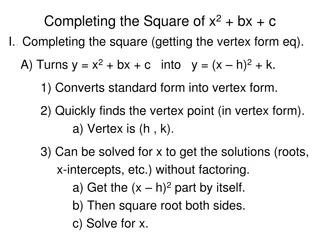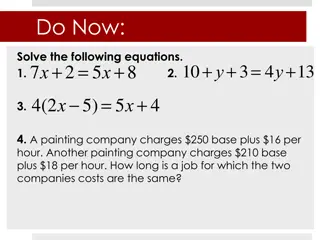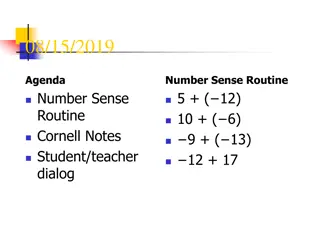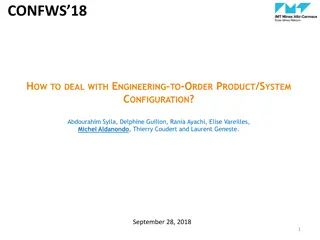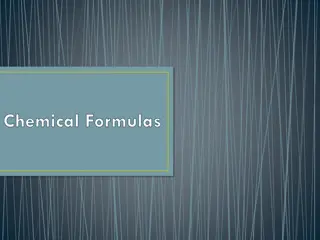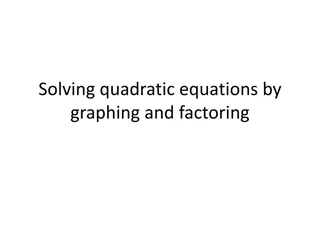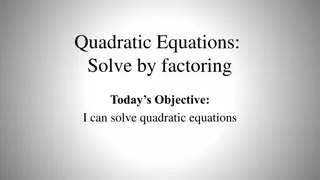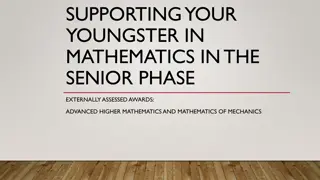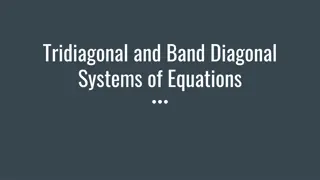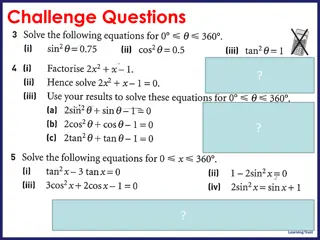Understanding First-Order Difference Equations in Mathematics
First-order difference equations involve solving both the homogenous and non-homogenous parts to find the general and particular solutions. By using forward substitution and candidate particular solutions, techniques like guessing and summing up the solutions help in solving these equations. This comprehensive guide will walk you through the steps with detailed explanations and examples.
Download Presentation

Please find below an Image/Link to download the presentation.
The content on the website is provided AS IS for your information and personal use only. It may not be sold, licensed, or shared on other websites without obtaining consent from the author. Download presentation by click this link. If you encounter any issues during the download, it is possible that the publisher has removed the file from their server.
E N D
Presentation Transcript
First-Order Difference Equation General Form: c Y + = ( ) c Y g t 1 0 1 t t Step 1: Solve the Homogenous Part c c c c + = + = 0 0 0 Y Y Y Y 1 1 1 t t t t 1 1 2
First-Order Difference Equation We solve with Forward Substitution. = = = = = = 1: 2: 3: t t t Y Y Y Y 1 0 Y Y 2 1 = = t h t ( ) ( ) Y Y Y A 3 2 0 t t t T = = : Y Y 1 T t 3
First-Order Difference Equation Step 2: Solve for the non-Homogenous Part (Particular Solution) c Y + = ( ) c Y g t 1 0 1 t t The candidate particular solution has the same algebraic form as g(t). ) First Case = ( ) g t (Where is a constant) c Y + = c Y 1 0 1 t t 4
First-Order Difference Equation = ( ) y t Guess: + + = + = = ( ) c c c c 1 0 0 1 ( ) c c 0 1 + ( ) 0 c c In order for to be a solution we need 0 1 + = ( ) 0 c c If multiply by t our guess. then this is not a solution and we have to 0 1 = ( ) y t t New Guess: 5
First-Order Difference Equation B) Second Case = + ( ) g t t 0 1 = + ( ) y t t Guess: 0 1 + + + + + + = + = = [ c c ] [ ( 1)] + c t c t c t 1 0 1 0 + = 0 1 0 c 1 + + c c + t c t t t 1 0 1 1 0 0 0 1 t 0 1 t 0 1 + = c c c 1 0 0 0 0 1 1 1 0 1 0 1 ( ) c c c 0 1 + 0 0 1 0 c c 1 1 0 1 1 6
First-Order Difference Equation = + 2 ( ) y t t t New Guess: 0 1 ) Third Case = B d t ( ) g t = C d t ( ) y t Guess: 7
First-Order Difference Equation + = 1 t t t c C d c C d d c C c C d c + + B d d 1 0 + = 1 t t t C d C d B d B d 1 0 c C d c C + = 1 t t ( ) B 1 0 = 1 ( ) c B d 1 0 = C ( ) c d c 1 0 B d = C d = p t p t ( ) t ( ) t y y d So: + ( ) c d c 1 0 8
First-Order Difference Equation + = ( ) 0 c d c If multiply by t our guess. then this is not a solution and we have to 1 0 t C d = t ( ) y t New Guess: Step 3: Sum the solution of Homogenous part and the particular solution = + GS t h t p y y y t 9
First-Order Difference Equation Step 4: Find the value of A = + = + GS t h t p t p t ( ) y y y A y t In order to find A we need an initial condition. If we know that for, we substitute the initial condition into the general solution and we take A. = = * * * ( ) y t t t y 10
1 = t 3 4 t=0, y(0)=0 Y Y 1 t t Step 1: Homogenous Solution = h t t h t t 3 0 =(- ) =3 Y Y y A y A 1 t t Step 2: Particular Solution = 4t ( ) y t C Guess: 11
1 = 1 t t t 4 4 3 3 4 4 = 4 C C C C C C C = 1 t t t 4 4 1 3 4 4 4 = 1 C = 3 4 C ( ) t = p t 4 4 y So: 12
1 Step 3: General Solution = + = + 4 4 GS t h t p t t 3 y y y A t Step 4: Find value of A = 4 4 + = + = = 0 0 (0) 0 3 0 4 0 4 y A A A = 3 ( 4) + 4 4 GS t t t y : 13
2 = 2 5 t Y Y 1 t t Step 1: Homogenous Solution = h t t h t t 2 0 =(- ) =2 Y Y y A y A 1 t t Step 2: Particular Solution = + ( ) y t a t b Guess: 14
2 + + + = 2 [ 2 5 0 = ( 1) ] = 5 t a t a t = b b a + t b b t 2 2 5 a t t a a b = = 5 10 a t a 2 b = p ( ) t 5 10 y t So: 15
2 Step 3: General Solution = + = GS t h t p t 2 5 10 y y y A t t Step 4: Find value of A = 5 0 10 1 = = = 0 (0) 1 2 10 1 11 y A A A = GS t 11 2 5 10 t y t : 16
Second-Order Difference Equation General Form: + c Y + = ( ) c Y c Y g t 2 1 1 0 2 t t t Step 1: Solve the Homogenous Part c c c c c c + + = + + = 0 0 0 Y Y Y Y a Y a Y 2 1 1 2 1 1 2 2 t t t t t t 2 2 2 17
Second-Order Difference Equation = t ty Guess: : + + = 2 0 a a 1 2 The solution depends on the roots = = 2 1 4 1 1) If >0 2 1,2 2 = + h t t ty A A So, the solution is: 1 1 2 2 18
Second-Order Difference Equation = = = 2 1 * 4 1 2) If =0 2 1,2 2 t second-order t t . = + h t t t y A A t So, the solution is: 1 2 19
Second-Order Difference Equation = = 2 1 4 a i 3) If <0 2 1,2 1 2 = 1 1[4 2 = 2 1 ] 2 = + h t [ cos( ) sin( )] ty r B tw B tw So, the solution is: 1 2 20
Second-Order Difference Equation General Form: + c Y + = ( ) c Y c Y g t 2 1 1 0 2 t t t Step 2: Particular Part A) If g(t)=G t y = Guess: 21
Second-Order Difference Equation + + = c c c G 2 1 0 G c = + + c c 0 1 2 = t y t ?? ?0+ ?1+ ?2=0 then new guess: 22
1 + = = = 5 6 0 y 1 y Y Y Y 1 1 2 0 1 t t t Step 1: Homogenous Solution + = + = = = 2 5 6 0 5 6 0 2 Y Y Y 3 1 2 1 2 t t t = + h t t 2 3 t y A A 1 2 23
1 Step 2: Find value of A = + = = + = = = 0 0 (0) 1 = 2 3 1 1 4 y A A + A A A A 1 A 2 1 2 1 3 1 1 ( 1) 1 2 3 1 y A 2 1 2 = 4 2 3 3 GS t t t y : 24
2 + = = = t 4 3 5 y 1 y Y Y Y 2 + + 2 1 0 1 t t t Step 1: Homogenous Solution + = + = = = 2 4 3 0 4 3 0 3 Y Y Y 1 + + 2 1 1 2 t t t = + = + h t t t 3 1 3 t y A A A A 1 2 1 2 Step 2: Particular Solution = 5t ( ) y t C Guess: 25
2 + + + = = 2 1 t t t t 5 4 5 C C 3 5 5 5 C C C C + 2 1 t t t t 25 5 5 C 4 + 5 5 1 = 3 5 C 20 3 C 1 8 = C 1 8 ( ) t = p t 5 y So: 26
2 Step 3: General Solution 1 8 = + = + + GS t h t p t t 3 5 y y y A A 1 2 t Step 4: Find value of A 1 8 1 8 7 8 1 4 5 8 = + + = + = = 0 0 (0) 1 3 5 1 y A A A A A 1 2 1 2 1 11 8 = = + + = + = 1 1 (1) 2 3 5 2 3 A y A A A A 2 1 2 1 2 1 4 5 8 1 8 = + + GS t t 3 5 t y : 27


